Hail damage assessment tools play a crucial role in evaluating the impact of hail events, particularly in regions like Ireland. The reliability of these tools, such as HailTrace and WeatherBug, is influenced by their data sources and algorithms, as well as external weather conditions like temperature and humidity, which can affect both hail characteristics and material responses. Understanding these factors is essential for making informed decisions regarding repairs and insurance claims.
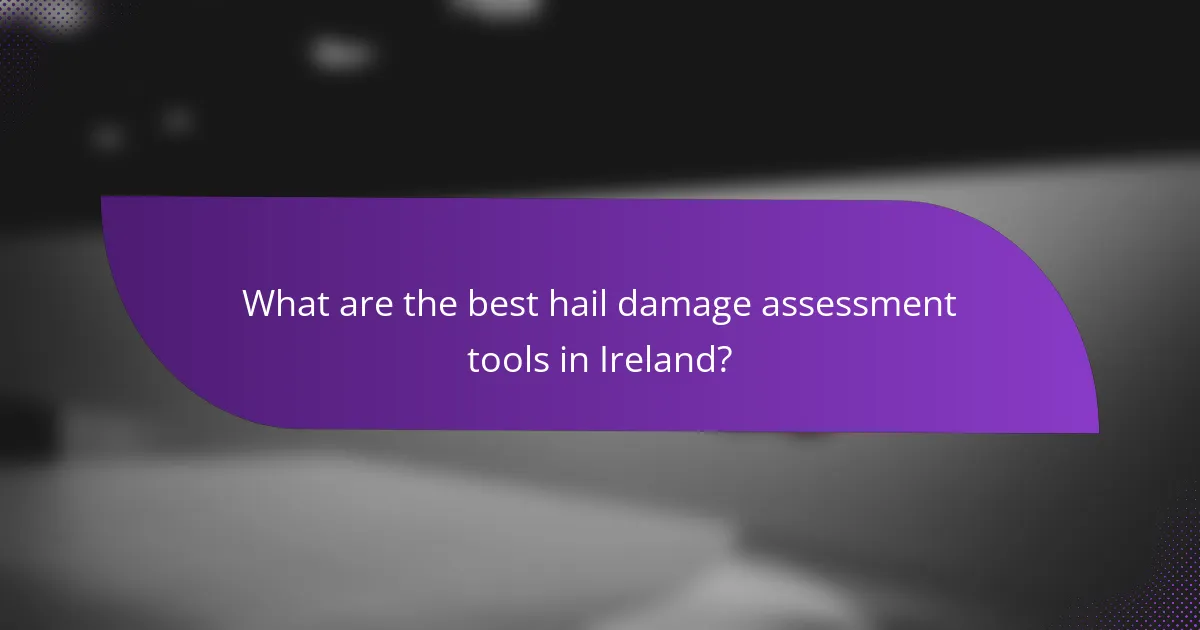
What are the best hail damage assessment tools in Ireland?
The best hail damage assessment tools in Ireland include HailTrace, WeatherBug, and AccuWeather. These tools provide valuable insights into hail events, helping users evaluate damage and make informed decisions regarding repairs and insurance claims.
HailTrace
HailTrace is a specialized tool that offers detailed hail reports and maps. It uses advanced radar technology to track hailstorms in real-time, providing users with information on hail size, duration, and path. This can be particularly useful for assessing potential damage to properties and vehicles.
When using HailTrace, consider its subscription model, which may vary in cost based on the level of detail and frequency of updates. Users should also be aware of the tool’s reliance on accurate weather data, which can fluctuate based on local conditions.
WeatherBug
WeatherBug is a comprehensive weather application that includes features for monitoring severe weather, including hail. It provides alerts and forecasts, helping users stay informed about potential hail events in their area. The app is user-friendly and accessible on various devices.
One advantage of WeatherBug is its community-based reporting system, which allows users to share real-time weather conditions. However, users should verify the accuracy of reports, as crowd-sourced data can sometimes be inconsistent.
AccuWeather
AccuWeather is a widely used weather service that offers detailed forecasts and alerts for hailstorms. Its advanced forecasting models provide users with timely information about severe weather, including the likelihood of hail. This can aid in proactive damage assessment and preparation.
While AccuWeather is generally reliable, users should be cautious of relying solely on its forecasts for critical decisions. Cross-referencing with other tools, like HailTrace, can enhance the accuracy of damage assessments and ensure comprehensive coverage of weather conditions.

How reliable are hail damage assessment tools?
Hail damage assessment tools vary in reliability based on their data sources and algorithms. While many tools provide valuable insights, their accuracy can be influenced by factors such as weather conditions and data integrity.
Accuracy rates of HailTrace
HailTrace is known for its high accuracy rates, often exceeding 90% in identifying hail events. This reliability stems from its use of advanced radar data and historical weather patterns to assess damage potential.
Users should consider that while HailTrace is effective, its accuracy may fluctuate based on the density of radar coverage in specific regions. For example, urban areas typically have better data resolution compared to rural locations.
WeatherBug’s reliability metrics
WeatherBug employs a network of weather stations and real-time data to deliver reliable assessments of hail events. Its metrics often indicate a reliability rate in the range of 80-90%, depending on the geographical area and available data.
When using WeatherBug, it’s important to cross-reference its data with local weather reports, especially during severe storms. This can help mitigate the risk of relying solely on one source for hail damage assessments.
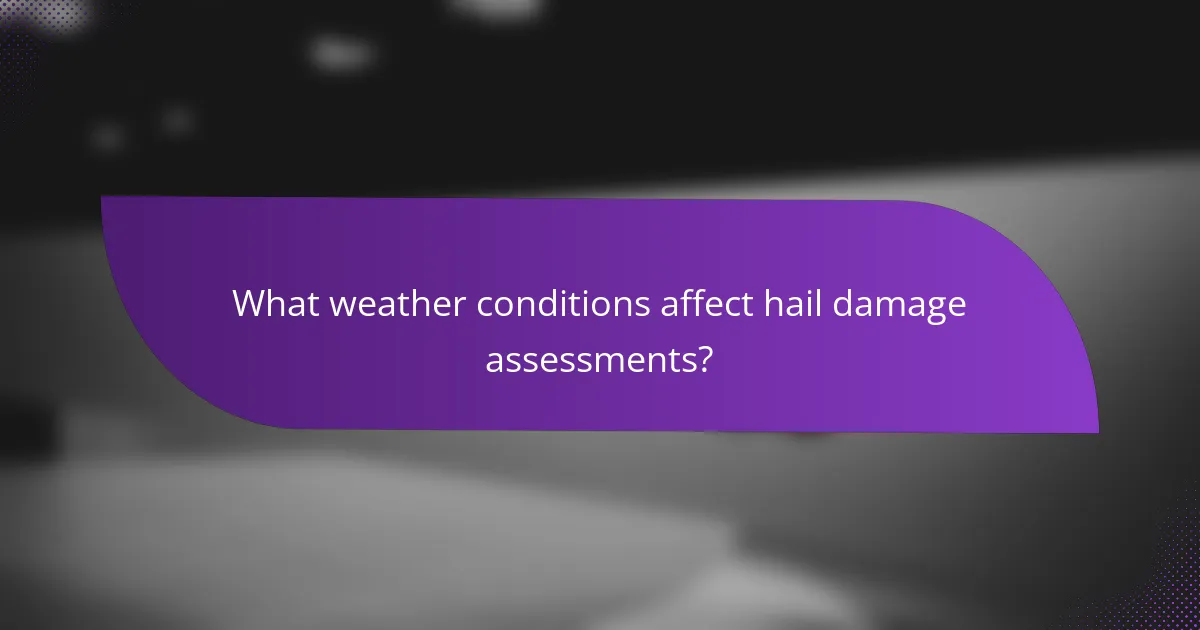
What weather conditions affect hail damage assessments?
Weather conditions such as temperature and humidity significantly influence the accuracy of hail damage assessments. These factors can alter the physical properties of hail and the materials being evaluated, impacting the overall reliability of the assessment process.
Temperature impacts
Temperature plays a crucial role in hail damage assessments as it affects both the formation of hail and the response of materials to impact. Warmer temperatures can lead to softer hail, which may cause less damage upon impact, while colder temperatures can result in harder, more damaging hailstones.
For example, hail falling during a warm afternoon may be less destructive than hail that occurs during a cold evening. Assessors should consider the temperature at the time of the storm when evaluating damage, as it can provide context for the observed effects.
Humidity effects
Humidity levels can also impact hail damage assessments by influencing the moisture content of materials. High humidity can lead to more water absorption in certain surfaces, making them more susceptible to damage from hail impacts.
In contrast, low humidity may result in drier materials that are more brittle and prone to cracking. Assessors should take note of the humidity conditions during and after a hail event to better understand the potential for damage to various surfaces.
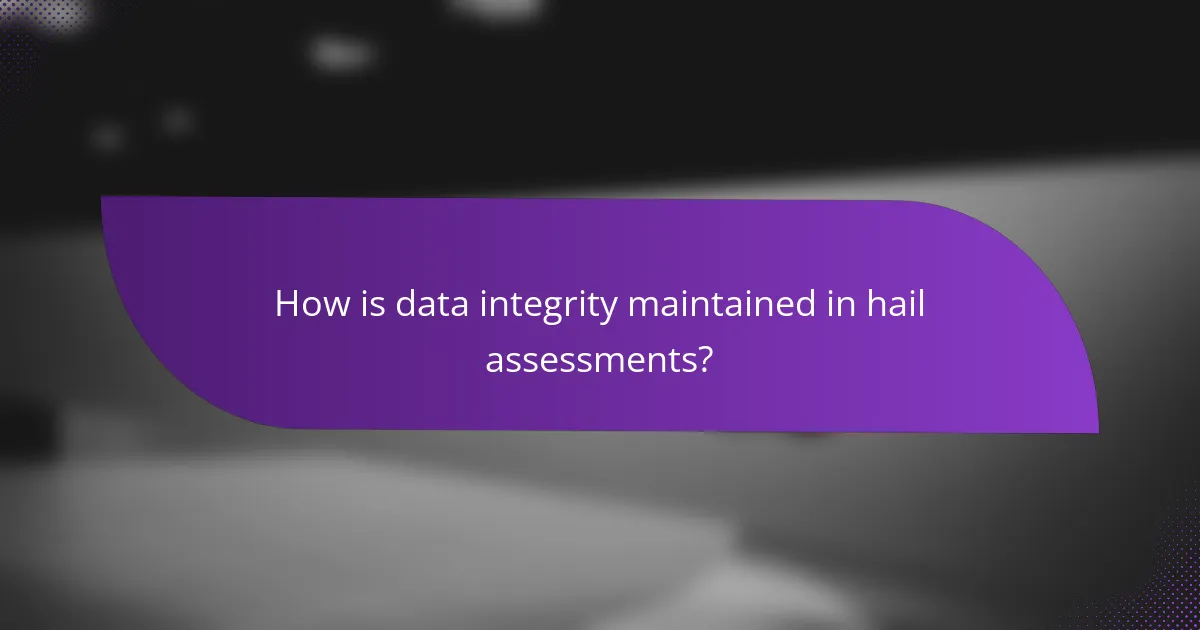
How is data integrity maintained in hail assessments?
Data integrity in hail assessments is preserved through systematic validation and verification processes. These practices ensure that the information collected is accurate, reliable, and free from corruption, which is essential for making informed decisions regarding damage evaluation and insurance claims.
Data validation processes
Data validation processes involve checking the accuracy and quality of the data collected during hail assessments. This can include cross-referencing data from multiple sources, such as weather reports and satellite imagery, to confirm consistency. For instance, if a hail event is reported, the size and frequency of hailstones can be validated against ground-level observations.
Common validation techniques include automated checks for anomalies, such as unusually high or low values, and manual reviews by experienced assessors. Implementing these processes helps mitigate errors and enhances the overall reliability of the assessment.
Source credibility checks
Source credibility checks are crucial for ensuring that the data used in hail assessments comes from reliable and authoritative sources. This involves evaluating the reputation and track record of data providers, such as meteorological agencies or research institutions. For example, data from national weather services is typically more trustworthy than that from unverified online sources.
Additionally, assessors should consider the methodology used by the source to collect and analyze data. Sources that adhere to recognized standards and protocols, such as those set by the World Meteorological Organization, are generally more credible. Regularly updating source lists and maintaining a database of trusted providers can streamline this process.
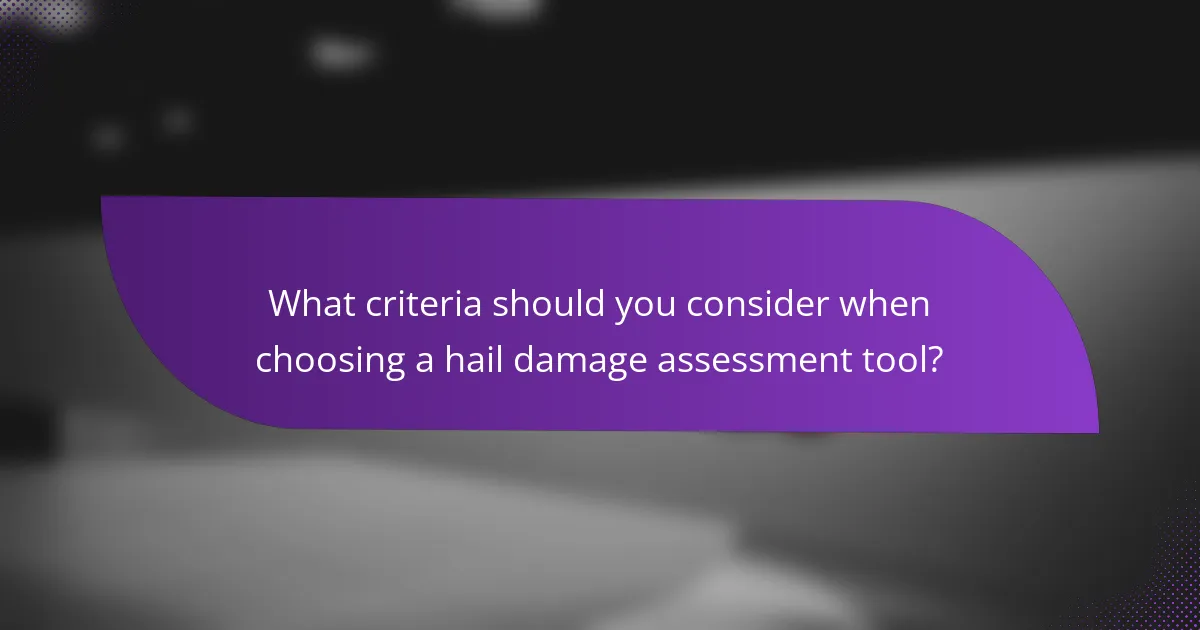
What criteria should you consider when choosing a hail damage assessment tool?
When selecting a hail damage assessment tool, consider integration capabilities, coverage accuracy, and data integrity. These factors ensure the tool effectively meets your needs and provides reliable assessments in various weather conditions.
Integration capabilities
Integration capabilities refer to how well the assessment tool connects with other systems, such as insurance platforms or weather data services. A tool that seamlessly integrates can streamline workflows and enhance data sharing, making it easier to manage claims and assessments.
Look for tools that offer APIs or compatibility with popular software used in the insurance or construction industries. This can significantly reduce manual data entry and improve overall efficiency.
Coverage accuracy
Coverage accuracy is critical for ensuring that the hail damage assessment reflects the actual impact on properties. Tools should provide precise geographical data and be able to analyze specific areas affected by hailstorms.
Consider tools that utilize high-resolution satellite imagery or local weather station data to enhance accuracy. A reliable tool should be able to assess damage within a few meters of the actual location, which is essential for accurate claims processing.
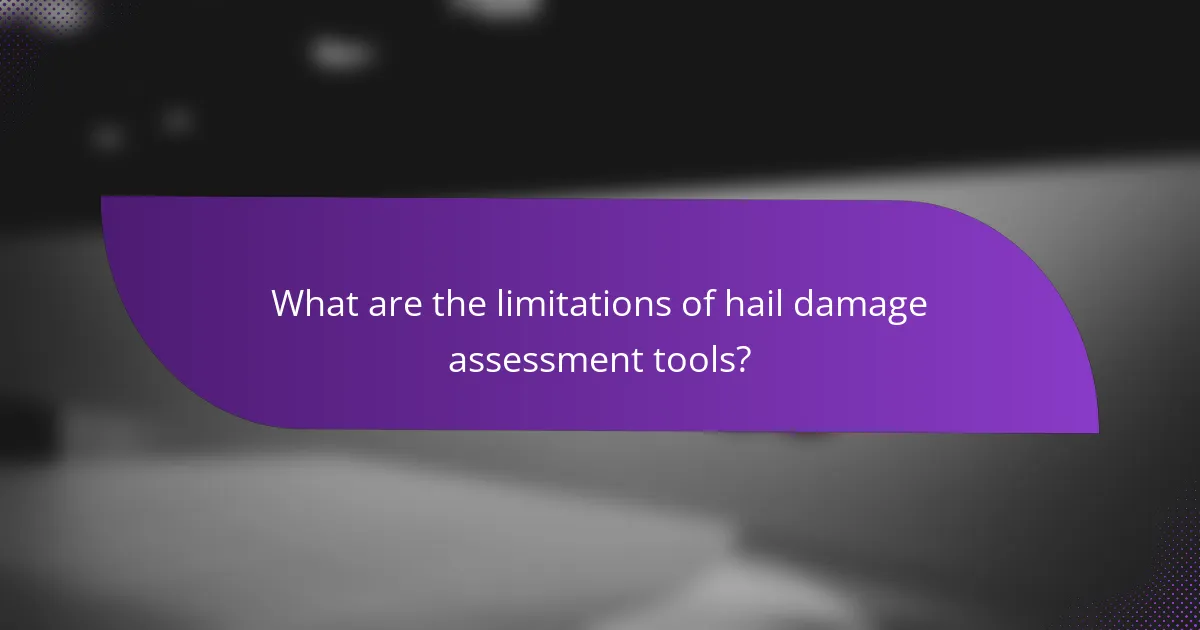
What are the limitations of hail damage assessment tools?
Hail damage assessment tools have several limitations that can affect their reliability and accuracy. Geographic constraints, data update frequency, and varying weather conditions can all impact the effectiveness of these tools in assessing hail damage.
Geographic limitations
Hail damage assessment tools often have geographic limitations that can hinder their accuracy. Many tools rely on localized data, which may not be available in remote or rural areas. This can lead to incomplete assessments or misinterpretations of damage in regions where data is sparse.
Additionally, the effectiveness of these tools can vary based on the specific climate and geography of an area. For instance, regions with frequent hailstorms may have more robust data sources compared to areas where hail is rare, resulting in less reliable assessments.
Data update frequency
The frequency with which data is updated can significantly impact the reliability of hail damage assessments. Tools that rely on real-time data may provide more accurate assessments, but many tools update data on a delayed basis, which can lead to outdated information being used for evaluations.
In practice, this means that if a hailstorm occurs, the assessment tool may not reflect the most current conditions for several hours or even days. Users should be cautious and verify the timeliness of the data before making decisions based on the assessments provided.

How do hail damage assessment tools integrate with insurance claims?
Hail damage assessment tools play a crucial role in the insurance claims process by providing accurate evaluations of damage, which helps streamline claim approvals and settlements. These tools utilize data from various sources, including weather reports and aerial imagery, to assess the extent of damage and facilitate quicker resolutions for policyholders.
Streamlined claims process
The integration of hail damage assessment tools into the claims process significantly reduces the time required for inspections and evaluations. By leveraging technology, insurers can quickly analyze damage reports and make informed decisions, often within a matter of days instead of weeks.
For example, when a hailstorm occurs, insurers can use these tools to assess damage remotely, minimizing the need for on-site inspections. This approach not only speeds up the claims process but also reduces operational costs for insurance companies.
To ensure a smooth claims experience, policyholders should familiarize themselves with the specific tools their insurers use and provide any necessary documentation promptly. Keeping records of previous claims and maintaining communication with the insurer can further enhance the efficiency of the claims process.
